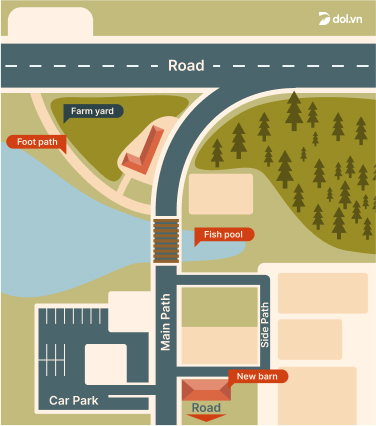Cambridge IELTS 11 - Listening Test 1 With Practice Test, Answers And Explanation
Luyện tập đề IELTS Online Test Cambridge IELTS 11 - Listening Test 1 được lấy từ cuốn sách Cambridge IELTS 11 với trải nghiệm thi IELTS trên máy và giải thích đáp án chi tiết bằng Linearthinking, kèm answer key và list từ vựng IELTS cần học trong bài đọc.
Section
👂️ Bài nghe section 1
The main hall seats 200
The
room seats 1001
Cost of main hall for Saturday evening:
£ + £250 deposit2 payment is required)3
Cost includes use of tables and chairs and also
4
Additional charge for use of the kitchen: £25
Will need a
licence5
Need to contact caretaker (Mr Evans) in advance to arrange
6
The building is no smoking
The band should use the
door at the back7
Don’t touch the system that controls the volume
For microphones, contact the caretaker
Need to know the
for the cleaning cupboard8
The
must be washed and rubbish placed in black bags9
All
must be taken down10
Chairs and tables must be piled up
❓ Tapescript section 1
🔥 Đáp án & giải thích section 1
Giải thích chi tiết
 Với section 1 thì sẽ thường có dạng câu hỏi điền tên đối tượng qua việc đánh vần, do đó khi bạn nhìn thấy Room (viết hoa) là bạn có thể biết ngay mình sẽ phải điền tên căn phòng này.
Với section 1 thì sẽ thường có dạng câu hỏi điền tên đối tượng qua việc đánh vần, do đó khi bạn nhìn thấy Room (viết hoa) là bạn có thể biết ngay mình sẽ phải điền tên căn phòng này.
 Ngoài ra, khi bạn nghe example, bạn đã thấy người nói nhắc tới 2 phòng, một trong đó là Main Hall
Ngoài ra, khi bạn nghe example, bạn đã thấy người nói nhắc tới 2 phòng, một trong đó là Main Hall
=> Xác định ngay đối tượng tiếp theo chính là đáp án.
 Do vậy, bạn nghe thấy Charlton Room (Or there's the Charlton Room)
Do vậy, bạn nghe thấy Charlton Room (Or there's the Charlton Room)
=> Đây là đáp án (bạn đừng lo lắng nếu không biết cách viết từ này, người nói chắc chắn sẽ đánh vần nó ra cho bạn ở các câu sau)
Section
👂️ Bài nghe section 2
Take care not to harm any
11
Not touch any
12
Wear
13
Not bring
into the farm, with certain exceptions14

❓ Tapescript section 2
🔥 Đáp án & giải thích section 2
Giải thích chi tiết
 Phần đầu là về những lời khuyên về việc du khách nên làm khi tới trang trại
Phần đầu là về những lời khuyên về việc du khách nên làm khi tới trang trại
=> Người nói nhắc là "I must give you some advice and safety tips …" là bạn biết đáp án sắp tới
 Ngoài ra, khi nhìn vào đề bài, bạn có thể biết đáp án là một danh từ (không làm hại cái gì)
Ngoài ra, khi nhìn vào đề bài, bạn có thể biết đáp án là một danh từ (không làm hại cái gì)
 Ở câu này, người nói nhấn mạnh luôn là "do not frighten or injure the animals" (harm = injure) =
Ở câu này, người nói nhấn mạnh luôn là "do not frighten or injure the animals" (harm = injure) =
> Đáp án là animals. 
Section
👂️ Bài nghe section 3
❓ Tapescript section 3
🔥 Đáp án & giải thích section 3
Giải thích chi tiết
 Ở câu này, mình cần tìm thông tin về chuyên ngành của học sinh
Ở câu này, mình cần tìm thông tin về chuyên ngành của học sinh
 Đầu tiên, Greg có nói là "the researchers were actually a mix of psychologists and physicists"
Đầu tiên, Greg có nói là "the researchers were actually a mix of psychologists and physicists"
=> Đây là thông tin đánh lạc hướng bởi Greg đang nói tới researchers (những người nghiên cứu) chứ không phải sinh viên
=> Loại B
 Tiếp, Lisa mention là "which students the study was based on"
Tiếp, Lisa mention là "which students the study was based on"
Section
👂️ Bài nghe section 4
areas containing many different species
important for locating targets for
31
at first only identified on land
identified hotspots for large ocean predators, e.g. sharks
found that ocean hotspots:
were not always rich in
32had higher temperatures at the
33had sufficient
in the water34
looked for hotspots for marine
35
found these were all located where ocean currents meet
found new ocean species living:
under the
36near volcanoes on the ocean floor
want to list endangered ocean species, considering:
population size
geographical distribution
rate of
37
Aim: to assess 20,000 species and make a distribution
for each one38
increase the number of ocean reserves
establish
corridors (e.g. for turtles)39
reduce fishing quotas
catch fish only for the purpose of
40
❓ Tapescript section 4
🔥 Đáp án & giải thích section 4
Giải thích chi tiết
 Đáp án là một danh từ (mục tiêu cho cái gì)
Đáp án là một danh từ (mục tiêu cho cái gì)
 Bạn sẽ nghe về định nghĩa của biodiversity hotspots trước theo thứ tự đã viết
Bạn sẽ nghe về định nghĩa của biodiversity hotspots trước theo thứ tự đã viết
=> do đó khi bạn nghe "These are the areas which have the greatest mixuture of creatures" là bạn biết đáp án sắp tới.
 Tiếp theo, "These areas are significant because they allow us to locate key areas for focusing efforts at conservation" (những vùng này quan trọng bởi chúng cho phép chúng ta xác định vùng trọng yếu để tập trung nỗ lực bảo tồn"
Tiếp theo, "These areas are significant because they allow us to locate key areas for focusing efforts at conservation" (những vùng này quan trọng bởi chúng cho phép chúng ta xác định vùng trọng yếu để tập trung nỗ lực bảo tồn"
=> Đáp án là conservation  ( significant = important và targets = key areas for focusing efforts )
( significant = important và targets = key areas for focusing efforts )


